While medical imaging is not typically characterized by intrigue, the ACR has zeroed in on a big mystery: the case of a missing radiologist. “Dr. Pickalock” has disappeared from her lab, leaving behind a trail of radiology-related clues that, if successfully decoded, will reveal her whereabouts. Curious and committed puzzle-solvers are collaborating to come to her rescue.
Stay calm; there’s no need to file a missing person report. The above scenario is the basis of an escape room mystery called
Radiology Escapes: A Virtual Adventure, which presents compelling, specialty-themed clues that help teams of participants solve the puzzle. The ACR initially designed the escape room as an in-person conference event to attract medical students to the field of radiology, but as COVID-19 spread nationwide, the organization moved the adventure online and provided guidance for groups to host it independently.
Casey Cable, MD, interventional radiology resident at Vanderbilt University Medical Center in Nashville, Tennessee, co-created the escape room with ACR staff and says that it’s a fun way to introduce medical students to radiology. “In medical school, you don’t get much exposure to radiology, and you don’t get it early enough in your training to help you decide that it’s the right career path for you,” he explains. “Many students don’t take a radiology rotation until their fourth year, at which point they’ve already applied into another specialty. So, I reasoned the escape room would be a great recruitment tool to attract students to radiology earlier in their journey.”
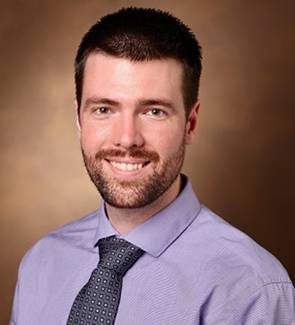
Casey Cable, MD, is an interventional radiology resident at Vanderbilt University Medical Center in Nashville and co-creator of the escape room. |
Since the ACR launched the program in 2020, nearly 400 participants, including medical students, residents, attending physicians, and other groups, have experienced the creative twist on medical imaging education that the escape room offers. Post-event surveys show that medical students who participated in the escape room found it enjoyable and learned more about the specialty. Additionally, the
ACR Medical Education & Student Outreach (MESO) team has leveraged the escape room to connect with numerous medical students about careers in radiology, raising the profile of the specialty.
“We’ve received feedback that the escape room experience has helped attract students to radiology, which was one of our primary goals,” says Michele Huneke, MT(ASCP), business analyst and manager for ACR Press and escape room co-creator. “Student programs don’t often include radiology, so they aren’t exposed to it. In some cases, the experience involves only sitting in the reading room watching radiologists interpret exams. By introducing radiology earlier, in a fun way, students may then consider it as an option for residency.”
Initiating the Adventure
Cable conceived the idea for the ACR escape room after he participated in a similar program that the University of Arkansas for Medical Sciences (UAMS) organized for radiology residents during the 2018 Radiological Society of North America meeting. Groups of approximately five residents from training programs across the country teamed up to compete against each other in a timed escape. UAMS puzzles included the use of ultrasound to find a secret code inside a gelatin brain mold and a lightbox to read and interpret a series of radiographs, which allowed teams to solve the puzzles required to escape a “locked dungeon.”
Cable recognized the educational value of the UAMS escape room and the following year, he presented a proposal to the ACR Resident and Fellow Subcommittee and then the ACR Education Committee to develop one for medical students. “I suggested that we create our own escape room focused on medical student outreach that would give students hands-on opportunities reading radiographs, CTs, and ultrasounds to get a really solid idea of what radiologists do in a typical day,” Cable says. “In doing so, we could target students who were trying to make up their minds about a career path.”
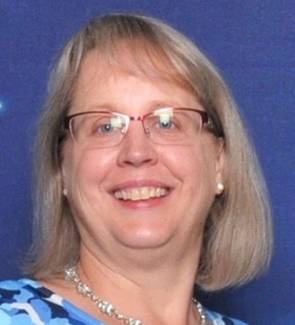
Michele Huneke, MT(ASCP), is a business analyst and manager for ACR Press and co-creator of the escape room. |
The committee approved Cable’s proposal to develop the adventure with mathematical, linguistic, and logic-based puzzles that include some basic elements of medicine and radiology. But the team knew they needed support from dedicated ACR staffers to develop the escape room and lead the project.
In August of 2019, Jan Cox, PHR, SHRM-CP, ACR senior director of operations, approached two ACR staff members who have an affinity for gamification and adventure films about working with Cable to co-create the escape room. Huneke is an escape room enthusiast, and Ted Reuss, MS, PMP, an ACR Press program manager, is an Indiana Jones movie fanatic.
“Jan’s timing was perfect: Our group at the ACR just had an excellent team-building experience at a local escape room, and we were jazzed about the idea of creating a radiology-themed one ourselves,” Reuss recalls. “Both Michele and I knew we’d be able to incorporate that much-needed fun element into the development process.”
Concentrating on Clues
To start, Cable, Reuss, and Huneke contacted the Association of University Radiologists/Association of Program Directors in Radiology, the organization that provided a grant for the UAMS escape room, for some background about how that team developed their clues and puzzle. Using their robust documentation as a foundation, Reuss and Huneke spent the next several months researching types of puzzles and modifying various clues to fit a medical student audience.
Ashmit Mittal, then a second-year medical student and member of the Medical Student Subcommittee that is part of the Resident and Fellow Section (RFS) of the ACR, consulted with the team to ensure that the clues were at an appropriate level for medical students and assisted with outreach of the escape room. “We felt it was important to incorporate the basics of radiology at the heart of the puzzles, as well as disease processes that students would learn early on in medical school. By also introducing students to unique concepts that are not normally taught in the curriculum, such as facts about scientists and physicians who helped pave the way in radiology, we were focused on capturing their attention and making them want to learn more about the field,” Mittal says.
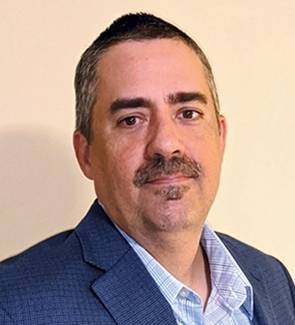
Ted Reuss, MS, PMP, is an ACR Press program manager and co-creator of the escape room. |
Escape room developers brainstormed radiology concepts and built off of UAMS’ puzzles to generate clues using Morse code charts, periodic tables, informational atlases/guides, and ciphers. One puzzle also incorporated a portable ultrasound machine so that participants could scan a giant gelatin brain where clues were hidden.
The developers incorporated a hands-on interventional radiology procedure for users to retrieve a missing key, as well as radiographs and CT scans — which Cable clinically certified — that revealed specific body parts and diagnoses, such as appendicitis, to decode clues. They provided hints and resources since participants weren’t required to have radiology-specific knowledge to solve puzzles. “We wanted to give med students a real taste of radiology so that they could see it’s an excellent specialty,” Reuss says. “If they haven’t moved toward a specific path in medicine, an ‘aha’ moment during the adventure could nudge them toward radiology.”
Once the team created the puzzles and established some ground rules — like no consulting smartphones during the adventure — they tested the escape room with groups of ACR employees. “Each time, we’d get feedback or just observe what worked well and what didn’t. We’d tweak and change and tweak and change until the adventure was totally ready to take on the road,” says Huneke, noting that the escape room launch goal was spring of 2020, in time to present the adventure to members at the ACR Annual Meeting.
Modifying the Setting
When spring of 2020 brought a global pandemic, it quickly became clear that no one was taking anything on the road. No live escape rooms occurred. “We were frustrated, but asked ourselves, ‘Well, what can we do now? How can we take this hands-on, live event and make it a virtual adventure?’” Huneke recalls.
She researched local Washington, D.C.–area escape rooms’ strategies and solutions for going virtual and crafted a plan for how an online collaborative event could work based on tools that were available. “We wanted to maintain the adventure’s interactivity even in a virtual setting. Preserving the team-based model in which participants work together was very important to us at the ACR,” Huneke says, noting the importance of collaboration in medicine.
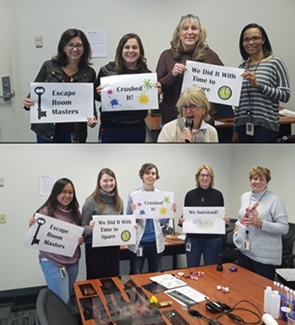
Groups of ACR employees engage in live testing of the ACR’s escape room pre-pandemic. |
First, the team tweaked the puzzles and clues that involved hands-on materials and physical radiology equipment, substituting them with digital images and other imaging-related content. They also leveraged a host of online tools, including video conferencing to facilitate participant interaction, document sharing to circulate the mystery’s clues, and digital survey forms to present the puzzles.
From there, the team developed a virtual process in which a moderator would lead the hour-long adventure — sharing a screen with “hints” to solve clues and helping groups navigate the mystery to find Dr. Pickalock. They also created a post-activity survey to gauge the impact and solicit participant feedback about the game. After extensive testing, Radiology Escapes: A Virtual Adventure went live in August of 2020.
The team soon realized that the virtual format provided an opportunity to reach a larger audience than an in-person venue could, including engaging older students and residents. With this in mind, the team developed an intermediate version of the virtual adventure tailored to third- and fourth-year students and radiology trainees; the original escape room is geared toward pre-med and first- and second-year medical students. Cable used medical training review books as guidance to target the optimal difficulty levels of the radiology-related clues.
Pre-health students, college cohorts, educators, and various radiology interest groups have also participated in the escape room. “We’ve been able to share this experience with a lot more people than would have been possible with the in-person version, which is a huge pro,” Cable says. “Since all you need is internet access, this tool is introducing medical students across the U.S. to the exciting and rapidly changing field of radiology. Even if they don’t ultimately choose radiology, they’ll understand how beneficial radiology is to whatever specialty they choose.”
Guiding the Journey
ACR staff facilitated the virtual escape room for several groups with positive results. This garnered the attention of the Stanford Center for Continuing Medical Education, which invited the ACR to present a CME Live session about how they pivoted from a live event to a virtual escape room. “The educators and faculty who attended our presentation thought the escape room was such a unique way to provide content, and they wanted to know how they could do it themselves,” Huneke says.
As interest in the escape room grew, the ACR team realized that it needed a more sustainable plan for running the program. “We just didn’t have enough staff to facilitate the escape room for every group that wanted to go through it,” Huneke says. After some consideration, the team determined that with the right tools, any leader could share their screen and run the adventure.
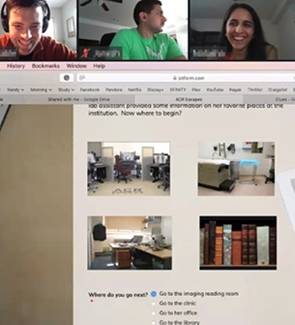
A screenshot of ACR’s Radiology Escapes: A Virtual Adventure. Casey Cable, MD, top left, leads the event. |
In February of 2021, the ACR released an eight-page, how-to guide for running the escape room independently. It explains the goals and objectives; the importance of knowing your audience; a host of tools and components, including live links for the survey form and clues; all of the puzzles, clues, and documentation required; a checklist of tips and tricks; and a contact email for ACR staffers who can answer questions. A participant guide, leader guide, and YouTube video also serve as detailed roadmaps for facilitation.
All of the links, materials, and resources are free to use — a boon during the pandemic. “We’re really seeing this take off as educators are running these virtual escape rooms with their medical students, because they can’t get together in person. This is a great method for students to collaborate in a fun, low-pressure situation,” Huneke says.
Suzanne Weiner, MD, assistant professor of medicine at Florida Atlantic University Schmidt College of Medicine in Boca Raton and director of the year four clerkships, took 55 of her students through the virtual escape room, which she described as “a very well done, fun, and different experience.” She says, “My students had been apart on rotations, and I thought it was important that they come back together and interact as a class. The escape room provided gamification, radiology education, and entertainment.”
Assessing the Impact
The ACR team created two post-participation surveys, one for the early student group and one for fourth-year medical students, residents, and physicians. The survey for the latter group requested feedback about the puzzles and possible areas for improvement. The responses were generally positive, although some said certain clues were “too easy.” The medical student survey asked if the escape room piqued their interest in radiology as a possible career path.
“When we got the answer ‘yes’ regarding interest in radiology, we knew we had done our job,” says Reuss, who notes that they also asked if the participant wanted to know more about a career in radiology. For students who affirmed interest, their contact information was sent to the MESO Committee for follow-up as part of the ACR’s broad focus on medical student outreach. Committee representatives emailed students, providing information about ACR’s opportunities.
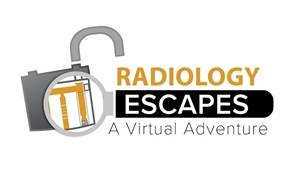
The ACR has created a how-to guide to help groups run the escape room on their own. |
Mittal, who both contributed some clues and participated in the virtual adventure, recalls being inspired after participating in the escape room. “I recognized many of the concepts I had learned in class, and it gave me confidence and motivation to continue exploring the field of radiology,” he says.
Based on positive feedback like this, the ACR continues to share the escape room and its companion materials with various groups, and the team hopes to run the program in person at various conferences once the pandemic recedes. “We’re providing a way to promote teamwork and collaboration while teaching participants about radiology in a fun way,” says Reuss.
With the comprehensive support resources available through the ACR, group leaders can facilitate their own educational escape room to promote radiology and provide a unique, collaborative experience for participants of all interest levels. “We encourage anyone who is interested in introducing radiology as a possible career path to host the escape room,” Reuss says. “It’s a fun and engaging way for students to learn about the specialty.”







